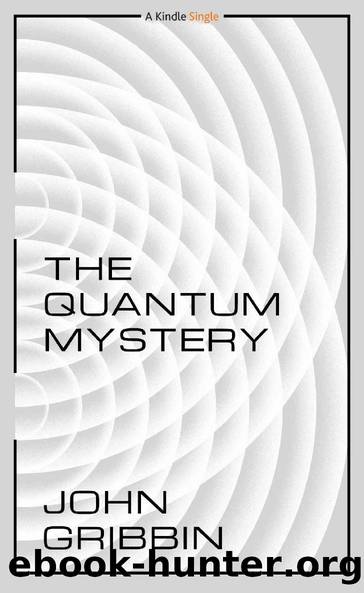The Quantum Mystery (Kindle Single) by John Gribbin

Author:John Gribbin [Gribbin, John]
Language: eng
Format: epub
Published: 2016-01-21T00:00:00+00:00
FIVE
Waving With Electrons
Louis de Broglie made one of those inspired leaps that are both truly profound and yet so simple that it leaves other people wondering, âwhy didnât I think of that?â Einsteinâs explanation of the photoelectric effect in terms of light quanta saw those quanta as real particles, which carried energy, related to their wavelength, or frequency, by the equation E = hν. But real particles also have a property called momentum, which physicists denote by the letter p, since m is reserved for mass. In the course of developing his special theory of relativity, Einstein also came up with an equation for the momentum of a photon, which is simply p = E/c, where c is the speed of light. It was de Broglie who put the two equations together and said that in that case the momentum of a photon is related to its frequency by the equation p = hν/c. Or, since wavelength, denoted by the Greek letter lambda, l, is simply the speed of light divided by the frequency, for light quanta p = h/l. This curious equation relates a fundamentally particle property, momentum, to a fundamentally wave property, wavelength. Weird enough for photons. But de Broglie didnât stop there. His inspired leap was to say that this equation must apply to any particle that has momentum, which means any particle. and to any wave which has wavelength, which means any wave. In particular, it must apply to electrons. Electrons should have a wavelength which could be measured by the same diffraction techniques used to study X-rays.
De Broglie presented his big idea in his Ph.D. thesis in 1924. His baffled Ph.D. supervisor, Paul Langevin, sent a copy to Einstein to ask what he thought of it. Einstein endorsed the idea with the comment, âI believe that it involves more than a mere analogy.â So de Broglie got his Ph.D., and the experimenters set out to test the idea.
Some experiments, in fact, had already been hinting at the wave-particle relationship, without anyone realizing it. Clinton Davisson was an American researcher who, in the early 1920s, had been looking at the way electrons bounce off a nickel surface. In 1926, he was on a visit to Britain, where he attended a lecture given by the German physicist Max Born. Born described de Broglieâs idea and its implications, then, to Davissonâs surprise, pointed out that the results of some of the scattering experiments carried out by Davisson and already published matched up with what would be expected if de Broglie was right. As soon as he was back in the USA, Davisson and his colleagues adapted their experiment to make a proper test of the electron wave theory.
The wavelength to be measured is predicted by turning de Broglieâs equation round to read l = h/p. Planckâs constant, h, is a very small number, so the predicted wavelength is unmeasurably tiny except for very small particles such as electrons, which have correspondingly small momenta. Davisson and his colleague Lester
Download
This site does not store any files on its server. We only index and link to content provided by other sites. Please contact the content providers to delete copyright contents if any and email us, we'll remove relevant links or contents immediately.
Sapiens: A Brief History of Humankind by Yuval Noah Harari(14166)
Sapiens by Yuval Noah Harari(5264)
Pale Blue Dot by Carl Sagan(4858)
Homo Deus: A Brief History of Tomorrow by Yuval Noah Harari(4777)
Livewired by David Eagleman(3624)
Origin Story: A Big History of Everything by David Christian(3590)
Brief Answers to the Big Questions by Stephen Hawking(3319)
Inferior by Angela Saini(3209)
Origin Story by David Christian(3117)
The Gene: An Intimate History by Siddhartha Mukherjee(3014)
Signature in the Cell: DNA and the Evidence for Intelligent Design by Stephen C. Meyer(2996)
The Evolution of Beauty by Richard O. Prum(2914)
Aliens by Jim Al-Khalili(2764)
How The Mind Works by Steven Pinker(2695)
A Short History of Nearly Everything by Bryson Bill(2579)
Sex at Dawn: The Prehistoric Origins of Modern Sexuality by Ryan Christopher(2441)
From Bacteria to Bach and Back by Daniel C. Dennett(2423)
Endless Forms Most Beautiful by Sean B. Carroll(2402)
Who We Are and How We Got Here by David Reich(2375)
